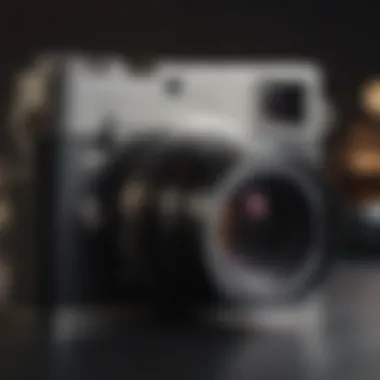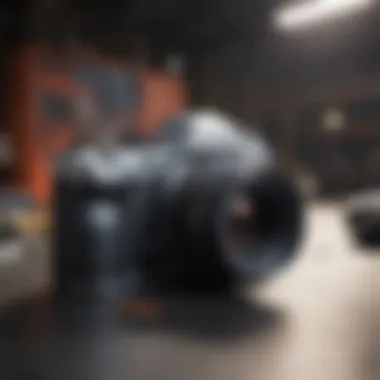Mastering Amateur Photography: Gear and Techniques


Overview
Prelims to the topic of the article
Amateur photography provides a unique avenue for self-expression and creativity. With the advent of affordable technology, more individuals are picking up cameras, eager to capture moments and develop their skills. The significance of camera choice cannot be overstated; it influences not just the visual quality of photographs, but also shapes the entire photographic journey. For beginners, understanding different camera types, their features, and suitable techniques is crucial in making informed decisions.
Brief background information
Photography, at its core, is about storytelling through images. The transition from being a casual snap-shooter to a more considered photographer requires both knowledge and practice. Countless resources exist for aspiring photographers, yet the overwhelming options in cameras and techniques can induce confusion. This article aims to clarify these aspects, detailing crucial camera features, contrasting different models, and offering guidance on how to harness photographic techniques effectively.
Features & Specifications
- Camera Types: Digital Single-Lens Reflex (DSLR), Mirrorless Cameras, Compact Cameras, and Smartphones. Each has its unique attributes catering to different styles and levels of expertise.
- Sensor Size: The quality of images can be greatly influenced by the size of the sensor. Full-frame sensors are superior yet often more expensive, while crop sensors are more accessible for beginners.
- Lens Versatility: Interchangeable lenses provide creative flexibility. Some cameras come with a prime lens ideal for portraits, while others may provide a zoom lens suitable for various situations.
- Image Stabilization: Important for capturing sharp images, especially in low-light conditions. This feature reduces the effects of camera shake.
Pros and Cons
Advantages of Various Camera Types
- DSLR Cameras: Excellent image quality, extensive lens options, and good battery life.
- Mirrorless Cameras: Compact size and advanced autofocus. They have fewer moving parts.
- Compact Cameras: Portable and user-friendly, perfect for casual photography.
- Smartphones: Ubiquitous and often equiped with quality image sensors, making them convenient for everyday use.
Disadvantages of Various Camera Types
- DSLR Cameras: Bulkier and heavier, harder to carry around.
- Mirrorless Cameras: Limited battery life can be a concern during long shoots.
- Compact Cameras: Less image quality compared to DSLRs.
- Smartphones: Limited manual control over settings.
User Experience
Real-world experiences with cameras can vary greatly. Many users praise DSLRs for their robustness and performance in diverse conditions. One photographer shares,
"Switching to a DSLR transformed my photography. The range of lenses allows me to explore different styles.”
On the other hand, users of mirrorless systems often express their satisfaction with portability. They enjoy the compact nature without sacrificing quality. Yet, it’s essential to consider the learning curve involved. Many beginners feel overwhelmed by the numerous settings and features available.
Buying Guide
When searching for the right camera, consider the following aspects:
- Skill Level: Choose a camera that matches your experience. A more complex camera might deter beginners.
- Budget: While it can be tempting to go for high-end equipment, there are quality products at various price points.
- Intended Use: Determine whether photography will be casual or more serious. This affects the type of camera best suited for you.
Understanding the Role of an Amateur Photographer
The realm of amateur photography encompasses a diverse group of individuals who engage with the medium primarily as a hobby. This section lays the foundation for understanding how amateur photographers navigate choices that affect their practice and creative development. Amateur photography is not just about taking pictures but involves a deep engagement with the craft, where understanding the tools and techniques significantly enhances the overall experience. By recognizing the role of an amateur photographer, we can better appreciate the passion and dedication that fuels this journey.
Defining Amateur Photography
Amateur photography refers to the art of taking photographs for pleasure rather than for profit. This category includes anyone who picks up a camera with the intention of capturing moments, exploring creativity, or documenting their surroundings. It is essential to note that amateur photographers vary widely in skill and intent. Some might aim for casual snapshots, while others may strive for artistic expression and mastery over photographic techniques.
An amateur's journey typically begins with a basic understanding of the camera, the principles of composition, and familiarization with essential techniques. This exploration can lead to a greater appreciation for the art form itself. Thus, defining amateur photography also involves recognizing the emotional and personal motivations behind the photographs taken. Engaging with photography can empower individuals to see the world differently, making them more observant and thoughtful.
The Transition from Amateur to Professional
The path from being an amateur photographer to becoming a professional often requires dedication and considerable growth in skills and understanding. This transition does not necessarily hinge on a simple acquisition of better equipment but rather on a significant development of one's artistic voice and technical competency.
Several factors differentiate amateur and professional photographers. Professionals often have refined their styles and are adept in the use of various camera settings and techniques. They understand how to commercialize their work, turning art into income.
For many, the journey entails taking workshops, learning from seasoned professionals, and building a portfolio that reflects their best work. Networking also plays a critical role in making the shift. Engaging with communities on websites like reddit.com can offer support, feedback, and opportunities.
"The line between amateur and professional is not just about skill but also about commitment and vision."
For those interested in taking their photography further, seeking mentorship and participating in collaborative projects can provide invaluable insights. Balancing passion with practical understanding is fundamental for any amateur looking to transition. Ultimately, the journey from amateur to professional is unique to each individual, influenced by personal goals, dedication, and the evolving landscape of photography itself.
Selecting the Appropriate Camera
Choosing the right camera is one of the most crucial decisions for an amateur photographer. The camera serves as a tool that not only captures moments but also influences the overall photographic experience. Different cameras offer various features, handling techniques, and image qualities that can significantly impact your journey in photography.
An appropriate camera can enhance creativity, facilitate learning, and improve the quality of photos. Understanding your needs and how different cameras function can help you make an informed choice.
Types of Cameras Available
DSLR Cameras


DSLR cameras are a popular choice among beginner and seasoned photographers. They are known for their versatility and high image quality. A key characteristic of DSLR cameras is their large sensors, which can capture more light, resulting in better images in low-light settings.
Additionally, DSLR cameras offer interchangeable lenses, allowing photographers to customize their setup based on the shoot requirements. However, they can be bulky and heavy, making them less convenient for travel or casual outings. Overall, DSLRs provide a solid balance of image quality and performance, which is invaluable for those who wish to learn and experiment in photography.
Mirrorless Cameras
Mirrorless cameras represent a modern alternative to DSLRs. These cameras retain high-quality images but come in a more compact design. The absence of a mirror not only makes them lighter but also allows for faster shooting. Key features of mirrorless cameras include electronic viewfinders and the ability to use a wide range of lenses.
These cameras are increasingly popular for their quick autofocus and continuous shooting modes. However, battery life tends to be shorter than that of DSLR cameras, which could be an inconvenience for long shooting sessions. Mirrorless cameras are suitable for those looking for portability without compromising quality.
Point-and-Shoot Cameras
Point-and-shoot cameras are known for their ease of use. They typically have fixed lenses and automatic settings, making them accessible to beginners who may find complex settings overwhelming. Their compact size allows for easy carrying, which is advantageous for everyday use and casual photography.
While point-and-shoot cameras have limitations in creative control and image quality compared to DSLRs or mirrorless options, they are a practical starting point for those exploring photography without a commitment to extensive equipment. As a beginner, mastering basic concepts with a point-and-shoot can lay a strong foundation for future progress.
Smartphone Cameras
In today's digital age, smartphone cameras are ubiquitous and have improved significantly. They come equipped with various features, including multiple lenses and editing tools. The convenience of having a camera readily available on your phone encourages spontaneous photography, making it a popular choice for many.
Smartphone cameras are limited by their small sensors and fixed lens options. However, for casual shooters or social media enthusiasts, they offer an excellent mix of convenience and functionality. Understanding their limitations is vital; nevertheless, they allow for creative expression without the need for additional gear.
Key Features to Consider
Sensor Size
Sensor size plays a crucial role in determining the image quality. Cameras with larger sensors can capture more light, resulting in better performance in low-light conditions. Many amateur photographers should pay attention to this feature for clear and detailed images. While larger sensors enhance quality, they often mean larger camera bodies, which is worth considering for portability.
Resolution and Megapixels
Resolution, usually measured in megapixels, indicates how much detail an image can hold. Higher megapixels allow for clearer prints in large sizes. However, for regular use, most amateur photographers do not need extremely high resolution. Understanding the balance between resolution and the purpose of the photography can guide better choices.
Lens Options
The availability of lens options affects flexibility and creativity. Many cameras allow for lens changes, which can significantly enhance your shooting experience. Different lenses suit various photography styles, from wide-angle for landscapes to macro for close-ups. Choosing a camera with good lens compatibility is advantageous for those looking to expand their skills.
Manual Controls
The ability to utilize manual controls is important for learning the fundamentals of photography. Cameras that offer control over settings like aperture, shutter speed, and ISO provide opportunities to experiment creatively. While automatic modes simplify the process, understanding manual features can foster growth in an amateur photographer's skillset.
Essential Accessories for Beginners
In amateur photography, the right accessories can significantly enhance the overall experience and results. While having a good camera is crucial, choosing the essential accessories tailored to your needs can elevate your skills and creativity. This section covers key accessories that beginners should consider, focusing on their importance and benefits in boosting photographic outcomes.
Lenses and Filters
Lenses play a pivotal role in photography. A standard kit lens may suffice for basic shots, but exploring different lenses allows for expanded creative choices. For instance, a prime lens often offers sharper images and broader aperture options. Telephoto lenses enable you to capture distant subjects while a wide-angle lens is beneficial for landscapes or group shots. Filters, such as polarizing or ND filters, can help in managing reflections, reducing glare, or controlling light exposure. Beginners should consider investing in versatile lenses and a few essential filters to enhance their photographic arsenal.
Tripods and Stabilizers
Tripods are indispensable for achieving stability in various shooting scenarios. They are particularly beneficial for long exposure photography, low-light conditions or capturing videos. A sturdy tripod can prevent blurriness caused by camera shake, ensuring crisp images. For those who prefer mobility, a stabilizer like a gimbal can help in keeping shots steady while on the move. Understanding the type of photography you wish to pursue can guide you in selecting the right tripod or stabilizer, making your work more professional.
Camera Bags and Storage Solutions
A well-designed camera bag is essential for protecting your equipment. It not only safeguards your gear from physical damage but also allows for easy organization and quick access. Opt for a bag that comfortably fits your camera and accessories, ensuring it is not cumbersome to carry. In addition, consider storage solutions for your memory cards and spare batteries. Investing in these small items ensures that you are well-prepared for any shooting situation. Being organized can have a direct impact on your photography sessions, allowing you to focus on capturing great shots rather than worrying about misplaced items.
"Investing in quality accessories can make a notable difference in your photography journey."
Fundamental Photography Techniques
Photography is much more than simply pointing and shooting. Understanding fundamental photography techniques can significantly enhance the quality of images produced, making the learning journey more rewarding. Mastery of basic techniques provides a strong foundation, allowing photographers to be more creative and expressive with their work. This article breaks down essential components of photography: composition, exposure, and focus techniques. Understanding each of these elements can elevate a photographer’s ability to capture stunning images.
Understanding Composition
Composition is the arrangement of visual elements within a photograph. It plays a crucial role in guiding the viewer's eyes and conveying the intended message or emotion. Good composition can make a basic subject appear compelling, while poor composition can detract from what might otherwise be a great image.
Rule of Thirds
The Rule of Thirds is a fundamental technique utilized in photography. It divides an image into three equal parts both horizontally and vertically, creating a grid. The key characteristic of this rule is placing focal points along the lines or at their intersections. This often results in more engaging and balanced photographs.
One unique feature of the Rule of Thirds is its simplicity. This makes it accessible for beginners and a beneficial choice in various scenarios, like landscapes and portraits. However, it can sometimes lead to predictable compositions if relied upon too heavily.


Leading Lines
Leading Lines use natural lines to draw the viewer’s attention towards the main subject. This technique encourages viewers to follow the lines, enhancing their engagement with the image. The characteristic of leading lines is their ability to create a sense of depth and perspective in a photograph.
It is a popular choice because it helps lead the eye into different areas of the photo, providing context and story. However, leading lines require careful consideration of the environment. Misguided lines can distract from the focal point.
Framing
Framing involves using elements within the scene to create a frame around the main subject. This technique can help direct the viewer's focus and add depth. The characteristic of framing is that it enhances visual interest and context.
Framing can be a advantageous as it adds layers to the image. However, overuse or ineffective framing can lead to a cluttered composition, which detracts from the subject.
Exposure Fundamentals
Exposure is vital for determining how light or dark a photograph appears. The exposure is controlled by three main elements: aperture, shutter speed, and ISO settings. A solid understanding of these aspects is essential for capturing correctly exposed images without losing critical detail.
Aperture
Aperture refers to the opening in a lens that allows light to pass through. It is measured in f-stops. A major characteristic of aperture is its effect on depth of field, which influences whether the background is sharp or blurred. A lower f-stop creates a shallow depth of field, ideal for portraits, while a higher f-stop increases depth of field, better for landscapes.
Aperture is beneficial for controlling light and artistic effects. However, a deeper understanding is needed as extreme settings can lead to undesirable effects in some situations.
Shutter Speed
Shutter speed controls how long the camera’s shutter is open to expose light to the sensor. It is key for freezing motion or creating motion blur. The characteristic of shutter speed is its critical role in action photography and low-light situations.
This technique is popular for capturing dynamic images, yet a slower shutter speed can lead to camera shake, causing blurry outcomes. It demands a steady hand or stabilization equipment.
ISO Settings
ISO indicates the camera sensor's sensitivity to light. It plays a crucial role in adjusting exposure, especially in low-light situations. The main characteristic of ISO is the trade-off between sensitivity and image quality; higher ISO settings can introduce noise or grain.
ISO settings are advantageous as they provide flexibility in various lighting conditions. However, excessive use of high ISO can degrade image quality; hence, careful adjustment is essential.
Focus Techniques
Correct focus is vital to ensure that the subject stands out sharply against the background. Focus techniques can significantly impact the clarity and quality of an image, influencing the viewer's experience.
Auto Focus vs Manual Focus
Auto Focus (AF) enables the camera to automatically adjust focus on the subject, making it a fast and convenient choice for beginners. The defining characteristic of AF is its efficiency in various situations, providing quick results.
Conversely, Manual Focus (MF) gives photographers more control, which can lead to creative adjustments, especially in complex scenes. However, it requires more practice to master. Auto Focus can sometimes focus on unintended subjects, so knowing when to switch to Manual is vital.
Depth of Field
Depth of Field (DoF) refers to the zone of acceptable sharpness within an image. The characteristic of DoF affects how much of the image is in focus. A shallow depth of field emphasizes the subject, while a greater depth brings more of the scenery into focus.
Understanding depth of field can enhance creative expression. However, it requires careful aperture selection depending on the visual intent. Each technique brings various aspects to the photographer's toolkit, allowing for creative and technical exploration.
"Mastering basic photography techniques is essential for anyone looking to improve their image quality and overall photographic skills."
In summary, grasping these fundamental techniques can vastly improve photography outcomes. Practicing composition, understanding exposure, and mastering focus techniques empower amateur photographers to create striking images.
Post-Processing and Editing
Post-processing and editing play a crucial role in the realm of amatuer photography. After capturing an image, the process of editing can greatly enhance the final result. Good editing can transform a decent photo into an exceptional piece of art, highlighting desired aspects and correcting flaws.
The benefits of post-processing are numerous. It allows photographers to adjust exposure, contrast, color balance, and sharpness. Additionally, editing provides the opportunity to remove unwanted elements, crop images for better composition, and apply creative filters. Considerations for post-processing include the balance between enhancing an image and preserving its natural appearance. Excessive editing can lead to unrealistic portrayals, reducing the image's authenticity.
Different editing software options exist to meet the diverse needs of photographers. Choosing the right software can depend on the user’s experience level and specific requirements.
Importance of Editing
Editing directly affects how effectively a photographer can convey a story or emotion through their images. An unedited photo may not fully represent the vision behind the shot. Editing allows for the adjustment of key factors like light and color, helping to create a specific mood or atmosphere. Furthermore, it serves as a platform for personal expression, allowing photographers to imprint their unique style on their work.
Common Editing Software
Adobe Lightroom
Adobe Lightroom is widely recognized for its powerful yet user-friendly interface. It provides robust tools for organizing and editing images. One of its key characteristics is the non-destructive editing feature, which allows users to revert back to their original photo at any point.


A unique feature of Lightroom is its ability to handle large batches of images efficiently. This is especially beneficial for amateur photographers who may work with numerous photos from a single shoot. However, it may require time to learn all its features effectively.
Adobe Photoshop
Adobe Photoshop is another favorite among photographers, known for its advanced capabilities. It allows for intricate adjustments to image layers and a vast range of creative options.
Photoshop's key characteristic is the depth of control it offers over individual elements of an image. This flexibility makes it popular for those seeking to apply detailed modifications. The unique feature of Photoshop is its content-aware fill, which allows for sophisticated editing, effortlessly removing objects or distractions. However, this complexity may be daunting for beginners.
Free Alternatives
For those reluctant to invest in software, free alternatives provide valuable options. Programs like GIMP or Pixlr offer many features found in premium software, catering to individuals on a budget.
The key characteristic of free editing software is accessibility. They tend to have a lower learning curve compared to their paid counterparts, making them useful for beginners. One unique feature of many free alternatives includes a community-driven aspect, where users can share tips and techniques online. However, these options may lack some advanced tools available in paid software.
Building a Photography Portfolio
Importance of Building a Photography Portfolio
Creating a photography portfolio is crucial for anyone serious about pursuing amateur photography. It acts as a visual resume, showcasing the photographer's skills and unique style. This collection of work helps to illustrate one's development and artistic vision over time. A well-organized portfolio can open doors for potential clients or collaborations, as it gives insight into what a photographer can deliver.
A strong portfolio serves multiple purposes. First, it assists in self-assessment, revealing areas of improvement and strengths. Second, it provides a conversation starter when networking with other photographers or industry professionals. Lastly, it’s a platform to present work online, making it accessible to a wider audience.
In summary, a photography portfolio is not just a collection of images; it's an expression of identity and creativity. Every amateur photographer should view it as a fundamental step for growth.
Selecting Your Best Work
When selecting images for a portfolio, the criteria should focus on quality and variety. Choose photographs that capture diverse subjects, styles, and techniques. This approach demonstrates versatility, appealing to a broader audience or client base. It is essential to highlight pieces that resonate emotionally, provoking thought or eliciting reactions.
Each selected photo should serve a purpose. Some should showcase technical skill, while others display creativity or storytelling ability. Be mindful of the presentation. Aim for a cohesive flow in the portfolio that reflects a particular style or theme.
Creating an Online Presence
Having an online presence is vital in today’s digital age. It allows amateur photographers to reach an audience and share their work efficiently. There are several platforms available for creating an online portfolio, offering unique features suited for specific needs.
Website Options
Creating a personal website is a fantastic choice for showcasing a photography portfolio. A website can be tailored to reflect your individual style and preferences. One key characteristic of this option is complete control over the layout and design.
A website like Wix or Squarespace provides user-friendly tools for building professional-looking portfolios without requiring advanced technical skills. The uniqueness of having a dedicated web address adds a sense of professionalism.
However, maintaining a website requires ongoing management and occasional updates. It is crucial to keep the content fresh and relevant.
Social Media Strategies
Utilizing social media is another effective way to create an online presence. Platforms such as Instagram and Facebook are widely popular among photographers. Their visual nature allows for easy sharing of images, which can attract followers and potential clients.
One primary characteristic of social media is its reach. Sharing work on these platforms helps connect with a vast audience. Social media also facilitates interaction with other photographers, enabling networking opportunities.
Despite its benefits, social media platforms often have constraints, such as algorithm changes which can affect visibility. Understanding how to utilize hashtags and engage with the community effectively is necessary for maximizing impact.
"A portfolio is a window into a photographer's world, highlighting the journey of creativity and skill development."
Furthering Your Photography Skills
Enhancing your photography skills is essential for anyone serious about this evolving craft. It is crucial to understand that photography is not just about capturing images; it involves expressing a vision and evoking emotions through visuals. By furthering your skills, you can achieve more consistent results, develop a personal style, and ultimately elevate your portfolio.
Participating in Workshops and Classes
Workshops and classes provide structured environments for learning. These venues allow you to gain hands-on experience under the guidance of experienced instructors. The benefit of interactive learning cannot be overstated. You get immediate feedback on your work, which is vital for understanding areas of improvement. In addition, you interact with fellow enthusiasts. Networking within this community can lead to collaborative opportunities.
Workshops often cover specific themes or techniques, such as landscape or portrait photography. These specialized sessions can deepen your understanding of particular aspects of photography and allow you to focus on your interests. However, the cost associated with workshops may be a consideration for many. Still, the investment can yield significant returns in skill enhancement and inspiration.
Learning from Online Resources
Tutorials
Online tutorials represent an accessible form of education that many photographers prefer. The flexibility of studying at one's own pace is a key feature. Most tutorials cover a wide array of topics, from basic camera settings to advanced editing techniques. The benefit here is the abundance of choices. Free tutorials are commonly available, appealing to beginners or those on a budget.
Additionally, platforms like YouTube host countless tutorials. The visual aspect of video guides aids in understanding complex techniques more clearly than text alone. One disadvantage is the variable quality of content; not all tutorials are produced with the same level of expertise.
Forums and Communities
Forums and communities serve as essential platforms for budding photographers. These spaces offer a sense of camaraderie among learners. You can pose questions, share experiences, and gain insights from a diverse group of enthusiasts. The interactive nature of forums enables peer learning, which can often lead to practical advice.
Moreover, many communities cater to specific genres of photography, allowing focused discussions. However, the quality of advice may vary. Not every contributor has the same level of experience or knowledge, so it's wise to consider multiple perspectives. Additionally, participation can sometimes be overwhelming with the sheer volume of conversations.
In closing, actively seeking to further your photography skills through both physical workshops and online resources creates a comprehensive learning experience. Leveraging various avenues ensures continuous growth and adaptation to new techniques, vital for any aspiring photographer.







